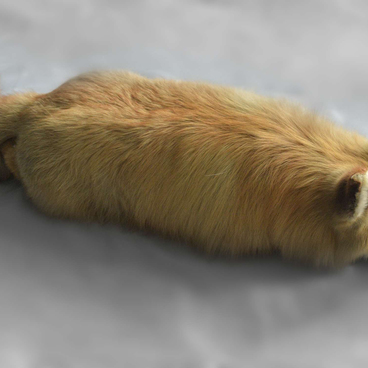The greylag goose is a member of the waterfowl family. It is one of the most well-known species of geese. Its name indicates that the bird’s plumage is mainly grey in color. The pattern on its stomach and neck resembles waves. The ends of the feathers on its back are white. Its beak is orange in color, at times with a pink hue. The wingspan is from 145 to 180 centimeters. The weight of an adult bird ranges from 2.1 to 4.5 kilograms. The length of tis body is 70 — 90 centimeters. The female greylag goose is significantly smaller than the male. Their nesting grounds in Russia are in the Kola Peninsula and Western Siberia. Along the Yenisei River basin, one can encounter greylag geese in the Minusinsk Hollow, Dauria and the forest steppe south of lake Baikal. They also nest around Lake Khanka but not in very large numbers.
Greylag geese migrate for the winter to the shores of the Mediterranean sea in Africa and Europe, and to the British Isles. They also spend winters in Afghanistan, Iran, Indochina, India and the shores of the Caspian Sea in Russia. Greylag geese primarily inhabit natural bodies of standing water and their bulrush covered shores. These include ponds for breeding fish, lakes and swamps. These birds sometimes live in wetlands, preferring the most inaccessible and secluded spots. Despite the fact that greylag geese swim and dive expertly, these birds predominantly feed on the ground where they feel more comfortable than in the water.
It is a very risk-averse bird. And yet it is also brave and very strong. If a greylag goose is wounded, it will still continue to counterattack by hitting the assailant with its wings, quite often seriously injuring even such large creatures as dogs.
These birds fly relatively low, but not when they are migrating elsewhere. Greylag geese reach pretty good heights whenever they undertake long journeys. These birds travel in flocks that number from tens to several hundreds. Their nesting grounds look like enormous colonies. Usually the greylag goose finds a partner before reaching nesting grounds. However, at times, they pair up on arrival. These birds start building their nests only when the snow and ice have completely thawed. They construct their nests out of leaves and reed stalks on top of knolls and mounds, from where there is a clear view of the surroundings, some distance from a water body. Greylag geese lay their eggs from March to May. There are from 4 to 12 eggs in one clutch. The eggshell is white, at times with a greenish or fawn-colored hue. Each egg, on average, weighs 190 grams. Only the female is responsible for incubating the eggs. If, for some reason, it needs to leave the nest, the bird covers the eggs up with its dawn feathers before departing. The male, who remains near the nest, warns its female partner about any possible dangers with its loud cries. The incubation period is 4 weeks long. As soon as the baby birds hatch, they almost immediately leave their nest. A couple of days later, the parents lead their offspring to the nearest water body, where they start to learn to search for food. If danger arises, the female protects the youngsters, while the male hides in a secluded spot. Greylag geese are distant predecessors of many sub-types of modern-day domestic geese.
Greylag geese migrate for the winter to the shores of the Mediterranean sea in Africa and Europe, and to the British Isles. They also spend winters in Afghanistan, Iran, Indochina, India and the shores of the Caspian Sea in Russia. Greylag geese primarily inhabit natural bodies of standing water and their bulrush covered shores. These include ponds for breeding fish, lakes and swamps. These birds sometimes live in wetlands, preferring the most inaccessible and secluded spots. Despite the fact that greylag geese swim and dive expertly, these birds predominantly feed on the ground where they feel more comfortable than in the water.
It is a very risk-averse bird. And yet it is also brave and very strong. If a greylag goose is wounded, it will still continue to counterattack by hitting the assailant with its wings, quite often seriously injuring even such large creatures as dogs.
These birds fly relatively low, but not when they are migrating elsewhere. Greylag geese reach pretty good heights whenever they undertake long journeys. These birds travel in flocks that number from tens to several hundreds. Their nesting grounds look like enormous colonies. Usually the greylag goose finds a partner before reaching nesting grounds. However, at times, they pair up on arrival. These birds start building their nests only when the snow and ice have completely thawed. They construct their nests out of leaves and reed stalks on top of knolls and mounds, from where there is a clear view of the surroundings, some distance from a water body. Greylag geese lay their eggs from March to May. There are from 4 to 12 eggs in one clutch. The eggshell is white, at times with a greenish or fawn-colored hue. Each egg, on average, weighs 190 grams. Only the female is responsible for incubating the eggs. If, for some reason, it needs to leave the nest, the bird covers the eggs up with its dawn feathers before departing. The male, who remains near the nest, warns its female partner about any possible dangers with its loud cries. The incubation period is 4 weeks long. As soon as the baby birds hatch, they almost immediately leave their nest. A couple of days later, the parents lead their offspring to the nearest water body, where they start to learn to search for food. If danger arises, the female protects the youngsters, while the male hides in a secluded spot. Greylag geese are distant predecessors of many sub-types of modern-day domestic geese.



